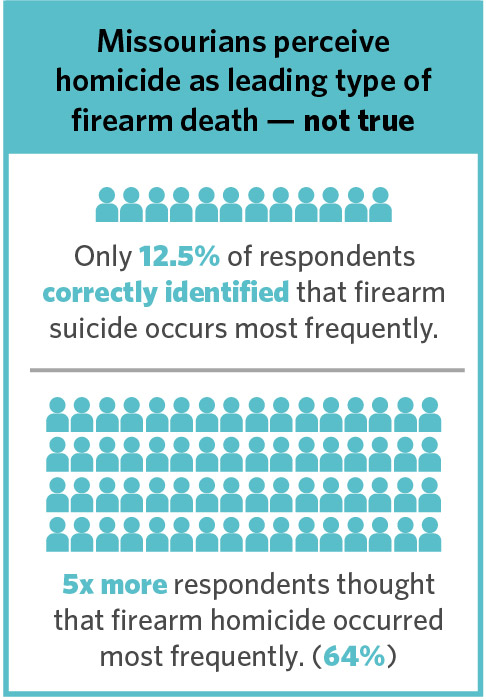
How did we not know? This is what more and more firearm owners are asking themselves in conversations involving suicide. A recent New York Times article highlighted this tragic question, as many people are unaware that gun suicides outnumber all other types of firearm deaths. In 2020, the Foundation conducted the Missouri Firearms Survey, and the data illuminated just how prevalent this misconception is.
Survey participants vastly underestimated the toll of firearm suicides, even though they account for 56% of gun-related deaths in the state. This is not unique to Missouri – suicides make up more than half of all firearm deaths nationwide. While news reports focus mainly on homicides, there is a separate, adjacent firearm-related epidemic occurring that we regularly underestimate as a society.

An estimated 60% of all suicides are by firearm, and this is important to note because the means matter. Suicide attempts using a firearm are much more lethal – over 80% of attempts end in death. Suicidal thinking comes and goes more quickly than many people realize, and easy access to firearms during a mental crisis can turn those momentary feelings of despair into an irreversible tragedy.
Further distorting the picture is the geography and where firearm deaths occur. Gun fatality rates in rural areas of Missouri, most of which are suicides, can rival firearm homicide rates in more densely populated parts of the state. Even so, suicides are not limited to one geographic area or demographic in the region. This crisis impacts every age group, gender, race, ethnicity, income, and education level. There are additional parallels with poverty rates, as the Kansas City Star recently highlighted as part of their ongoing Missouri Gun Violence Project (supported in part by Missouri Foundation for Health and Report for America).
The scope of this crisis is why Missouri Foundation for Health is tackling firearm suicide prevention explicitly. As part of this work, we are supporting seven organizations that are participating in a two-year collaborative learning experience with the intention of developing community-based strategies to address firearm suicides.
In order to make real traction and address suicide rates in Missouri and in the nation, firearms must be a part of the conversation. Approaches to suicide prevention at local, state, and national levels should include a focus on addressing and reducing access to lethal means in a variety of ways, including, but not limited to, safe storage options and limiting access to firearms when people may be facing a crisis or behavioral health issue.
The question we should be asking ourselves as firearm suicide rates continue to climb throughout the state is no longer “How did we not know?” Instead, we need to be asking “Now that we do know the strong connection between firearms and suicide, how do we come together as a state to end this epidemic?”
If you or someone you know is contemplating suicide, please call the National Suicide Prevention Lifeline at 1-800-273-8255.


